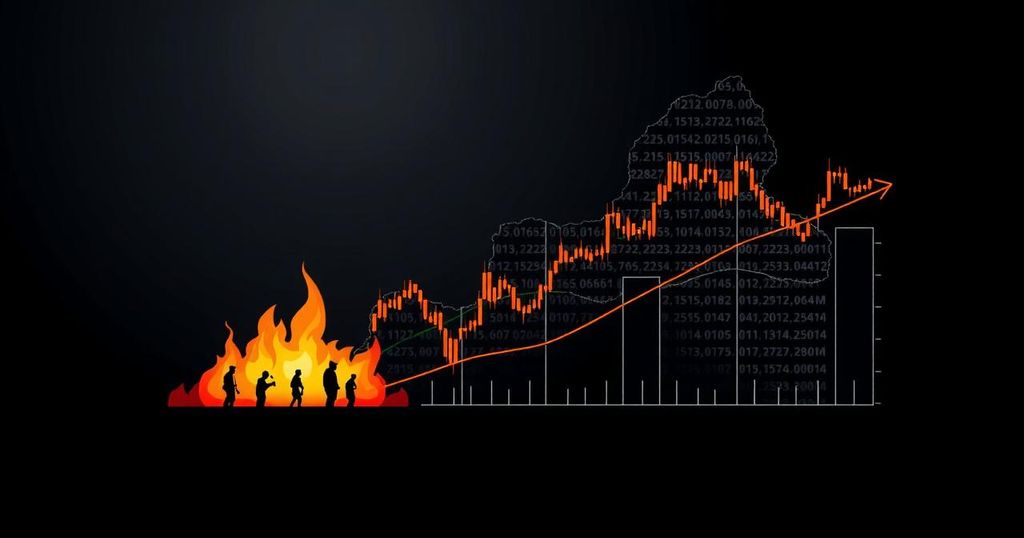Will the Israel-Gaza Conflict Hinder Bitcoin’s Post-Fed Rate Cut Rally?
Summary
The Israel-Gaza conflict threatens potential Bitcoin rallies linked to a US Fed rate cut, as escalating tensions are likely to induce market panic and sell-offs. Historical patterns indicate that Bitcoin might face significant price drops, with predictions suggesting a fall below $50,000. While experts express long-term optimism due to impending monetary easing, immediate uncertainties overshadow this potential for growth.
The ongoing Israel-Gaza conflict presents significant challenges to any potential rally in Bitcoin prices that might follow an anticipated US Federal Reserve (Fed) rate cut. As tensions escalate in the region, market uncertainties are expected to arise, prompting potential sell-offs in Bitcoin and other cryptocurrencies. Analysts, including Doctor Profit, have warned that such geopolitical instability typically drives investors toward more secure assets, impacting riskier investments like Bitcoin adversely. Historically, BTC has experienced price declines during periods of heightened conflict, as evidenced by a notable 3% drop in October 2023 linked to the Israel-Hamas situation. Similarly, subsequent escalations, such as Iran’s attacks on Israel, resulted in significant downturns for the cryptocurrency. Analysts predict that the current situation could similarly stymie Bitcoin’s expected upward trajectory following the Fed’s rate cut announcement slated for September 18. The Israeli government’s intention to escalate its military efforts in Lebanon adds to the prevailing market anxiety, potentially influencing Bitcoin’s performance negatively. Though a Fed rate cut generally signals a bullish climate for BTC due to increased liquidity, the current geopolitical stresses may thwart immediate positive market responses and contribute to predictions of Bitcoin prices dropping below the pivotal $50,000 mark. Financial observers like Peter Schiff have expressed concerns, predicting sharp declines to $42,000 or even as low as $20,000, with technical analysts noting significant bearish patterns developing in Bitcoin’s market charts. Even with the prevailing uncertainties, some industry experts remain optimistic about Bitcoin’s mid to long-term prospects, suggesting that anticipated monetary expansions related to the Fed’s actions could ultimately stabilize the market. In summary, while the prospect of a rate cut typically bodes well for Bitcoin, the current geopolitical landscape and its implications may cap immediate gains, complicating the outlook for the asset in the short term.
The article discusses the potential impacts of the Israel-Gaza conflict on Bitcoin’s price trajectory, particularly in relation to the anticipated US Federal Reserve rate cut. The significance of geopolitical events on financial markets, especially for riskier assets like cryptocurrencies, is a prevailing theme. Historical data reveals that conflicts tend to increase market volatility, often resulting in price declines for cryptocurrencies amid investor caution. Analysts’ predictions and market sentiment are critical components in understanding these dynamics and forecasting Bitcoin’s performance in the face of regulatory and geopolitical shifts.
The geopolitical tensions from the Israel-Gaza war are poised to pose substantial challenges for Bitcoin’s expected price rally following the impending US Fed rate cut. Market uncertainty and fear typically associated with such conflicts may lead to sell-offs, undermining the potentially favorable impact of monetary easing. Although long-term optimism remains in the air with expected liquidity increases, the immediate outlook for Bitcoin appears fraught with risk, with many analysts predicting significant declines over the short term.
Original Source: coingape.com








Post Comment